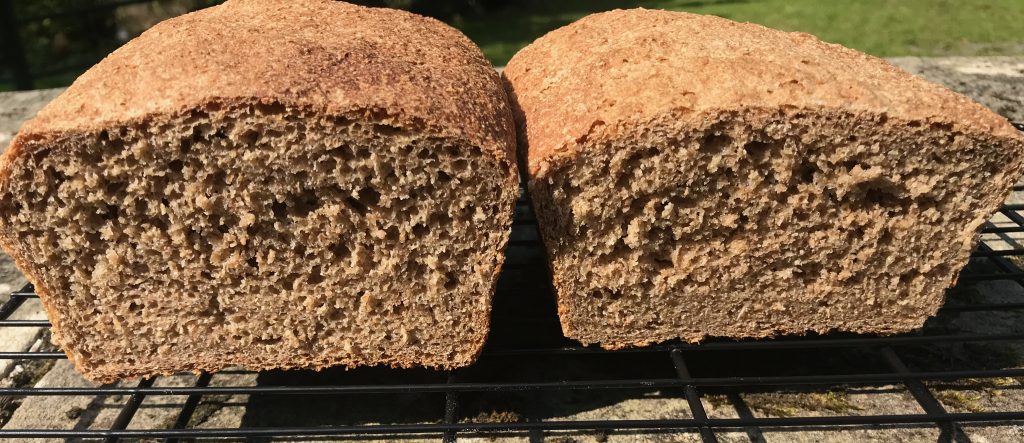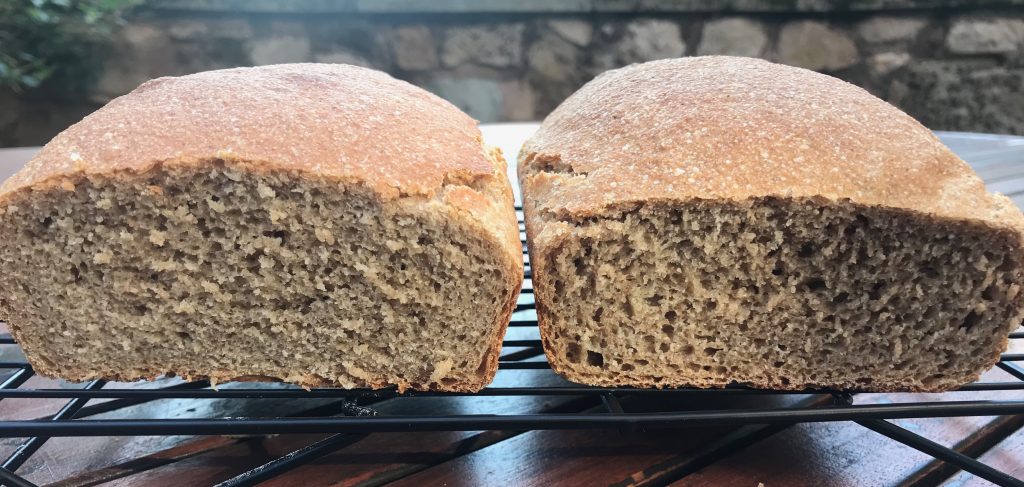This is the third in a series of experimental bakes testing the grain grown organically by Mark & Liz Lea at Green Acres Farm, Shropshire in Harvest 2020. Previous experiments tested Crusoe and Siskin and Yeoman and Rivet.
The experiments use freshly milled grain and are based on a yeasted loaf, using the stretch and fold method.
The grains are both milled on the same settings using the double milling method. They are first milled coarsely and the coarse grain is milled again on a fine setting.
The grain is tested as a freshly milled wholemeal and an extraction flour. The extraction flour is sieved through a coarse sieve and again through a finer sieve. White flour is a 70-72% extraction rate. Flour that is freshly milled and sieved at home is never really white flour, rather it is flour with most of the bran removed.
The notes below should be read in conjunction with Notes on Freshly Milled Flour to understand the limitations of using freshly milled flour.

Coppice Blend
This is a really interesting population wheat that Mark and Liz have put together, inspired by Martin Woolf’s Wakelyn’s YQ. Mark has selected from the wheats that have grown on his farm over the last forty years and blended them together so that they grow as a population. In this way, the blend is made up of some wheats that resist disease and some that will stand tall throughout the most difficult growing season and the blend will develop with each year, self selecting the strongest and most suited to the farm conditions becoming a harvest that offers both great taste and good yield. The blend is named after the original name of the Lea family farm, before it was compulsory purchased by the local council for an industrial estate.
Because the blend has selected wheats that are well suited to bread making, this grain, made a great loaf. The gluten developed well, it had the elasticity you would expect when freshly milled, the final loaf rose beautifully, in fact it was the best performing in this area of all the wheats tested. It has a lovely taste, sweet and nutty. It is a lovely grain to work with and makes a tasty bread.
Data for Coppice Blend 2020
In tests the Coppice Blend had a Hagberg Falling Number (HFN) of 289 and a protein of 11.4%.
It mills into a rich dark brown wholemeal flour with an extraction rate of 78% maintaining a darker colour, suggesting that it has a softer bran (it is important to note that the only true comparison is the flour milled at the same time, in this case the Malice X Holdfast, which had an extraction rate of 76%)
Taste Test for Coppice Blend
This is a pleasant tasting wheat, not as complex as the Rivet or as sweet as the Mulika Holdfast, but sweet and nutty with an excellent texture and rise.
Mulika X Holdfast
A variety developed by Ed Dickin at Harper Adams by crossing a modern variety Mulika with its disease resistance with an older variety Holdfast (first developed in 1935) to combine the strengths of both.
Performance
This grain performs well as a bread flour, even with freshly milled flour their was some elasticity in the dough development and the loaves rose as expected for fresh flour. It mills as a lighter coloured flour than the Coppice Blend and achieved a slightly higher extraction rate with the same double milling at 76%.
Taste test
This is an exceptionally sweet flour. It rose as expected with a good crumb structure. It makes a tasty loaf of bread.

The photo above shows the two extraction flours. Mulika X Holdfast is pictured on the left. Please note that these are smaller loaves than the wholemeal because they are both based on 500g flour before extraction. The Mulika X Holdfast is made with 380g flour and the Coppice Blend is made with 390g flour.

